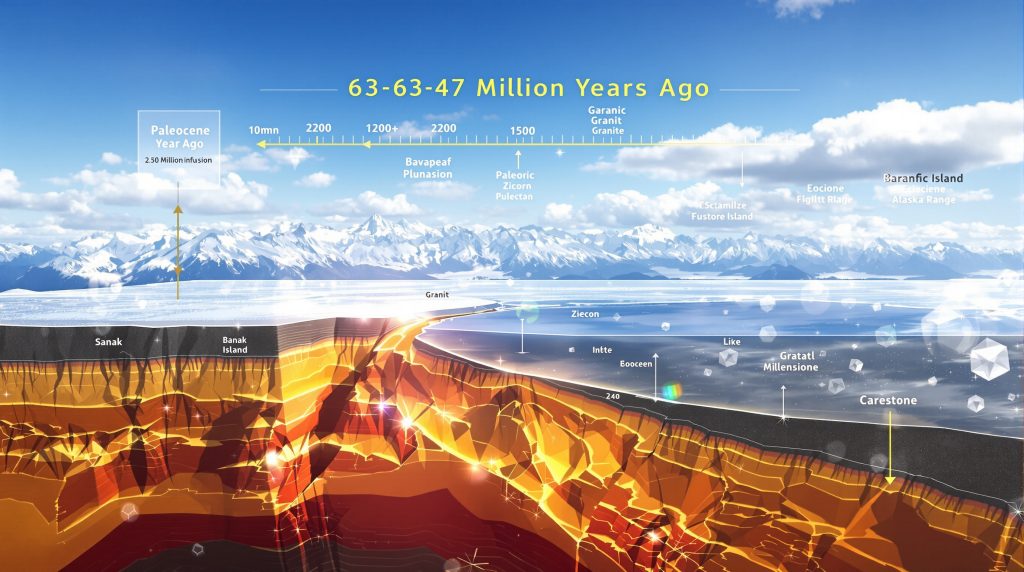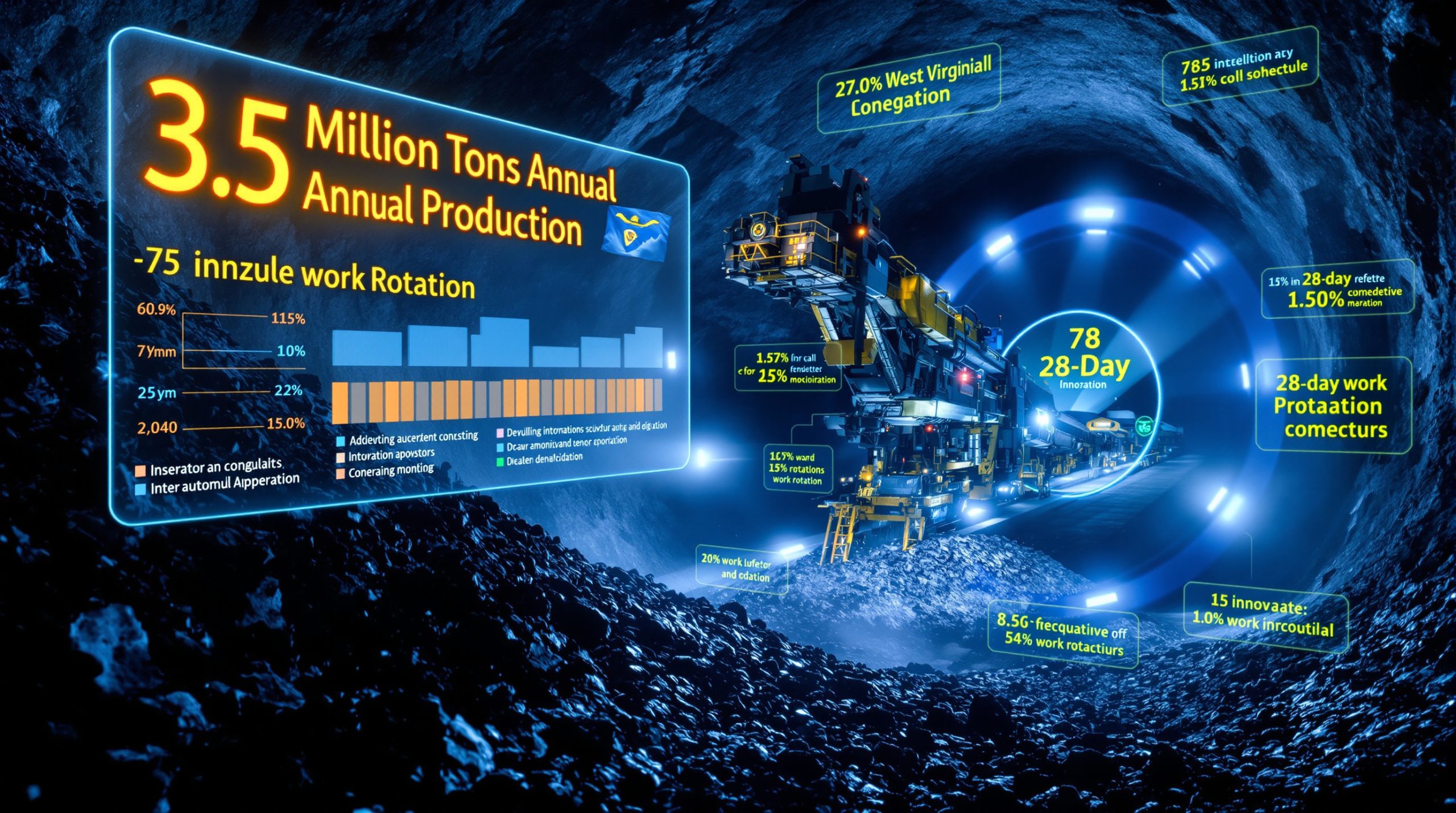Understanding Alaska's Ancient Magmatic System
The Sanak Baranof Plutons represent one of Alaska's most fascinating geological mysteries, stretching across more than 2,200 kilometers of rugged coastline from the remote Sanak Island in the west to the scenic Baranof Island in southeastern Alaska. These ancient igneous formations, created between 63 and 47 million years ago during the Paleocene to Eocene epochs, challenge conventional understanding of how and where granite bodies typically form in subduction zone settings.
Unlike typical plutonic systems that develop 100-150 kilometers inland from oceanic trenches, the Sanak Baranof Plutons intrude directly into what geologists call an accretionary wedge complex. This unusual positioning within the Chugach-Prince William terrane has sparked decades of scientific investigation and debate about the tectonic processes that could create such formations.
Formation Through Magmatic Intrusion
The term "pluton" refers to large masses of igneous rock that formed when magma cooled and solidified within the Earth's crust, never reaching the surface as volcanic eruptions. These particular plutons consist predominantly of granite, with some tonalite and granodiorite compositions, all characterised by high aluminium content that geologists classify as paraluminous.
The paraluminous nature of these rocks provides crucial evidence about their formation process. When mantle-derived magmas rise through the crust, they encounter and partially melt aluminium-rich sedimentary rocks, particularly the interbedded sandstones and shales known as turbidites. This mixing process creates the distinctive chemical signature that marks the Sanak Baranof Plutons.
Key Characteristics of Sanak Baranof Plutons:
• Geographic extent spanning over 2,200 kilometers of Alaskan coastline
• Age range from 63 to 47 million years old
• Predominantly granite composition with high aluminium content
• Direct intrusion into accretionary wedge sediments
• Systematic age progression from west to east (in western portions)
Geographic Distribution and Mapping
The plutons follow the curvature of southern Alaska's coast, embedded within the broader geological framework of the Chugach-Prince William terrane. This terrane represents one of the most extensive accretionary wedge complexes in North America, composed primarily of turbidite sequences that were scraped off the oceanic floor and added to the continental margin during subduction processes.
The western terminus at Sanak Island contains the oldest plutonic rocks at approximately 63 million years, whilst the eastern terminus on Baranof Island hosts the youngest formations at around 47 million years. This geographic and temporal distribution forms a crucial part of the geological puzzle that researchers continue to investigate.
Furthermore, modern geological logging codes have become essential for documenting these complex formations, enabling researchers to systematically record the intricate relationships between different rock types and structural features.
Temporal Evolution: A Tale of Two Belts
Recent research has revealed that the Sanak Baranof Plutons actually represent two distinct belts with different age patterns and formation characteristics. This discovery has significant implications for understanding the tectonic processes that created these unusual formations.
Western Belt: Systematic Age Progression
The western belt, spanning from approximately 63 to 56 million years ago, displays a clear systematic progression where plutons become younger from west to east. This pattern suggests a coherent geological process that swept along the margin over time, creating plutonic bodies in sequence.
Research using uranium-lead dating on zircon crystals has revealed that Sanak Island plutons represent the oldest components at 63 million years, with ages decreasing systematically eastward. This temporal pattern provides important clues about the tectonic mechanism responsible for pluton generation.
The western belt plutons also contain distinctive metamorphic mineral fragments called xenocrysts, specifically andalusite crystals that indicate formation at relatively shallow depths of no more than 12 kilometres. This suggests the accretionary wedge was relatively thin in western regions during pluton formation.
Eastern Belt: Complex Formation History
The eastern belt, ranging from 55 to 47 million years ago, shows much more complex age relationships that do not follow the simple west-to-east progression seen in the western belt. This complexity suggests different or more varied tectonic processes affected the eastern portions of the system.
A prime example of this complexity is the Crawfish Inlet pluton on Baranof Island, which shows ages ranging from 47 to 53 million years. This represents a composite pluton where igneous rocks were injected and crystallised over a period of 6-7 million years, creating a complex internal structure.
The eastern belt plutons contain kyanite xenocrysts instead of andalusite, indicating formation at greater depths and suggesting the accretionary wedge was much thicker in eastern regions, particularly around Prince William Sound and the Anchorage area.
The Ridge Subduction Solution
The unusual location of the Sanak Baranof Plutons within the accretionary wedge, rather than in the typical volcanic arc position, requires a special tectonic explanation. Since the 1970s, following the development of plate tectonic theory, scientists have increasingly favoured ridge subduction as the dominant explanation for these formations.
Understanding Ridge Subduction Dynamics
Ridge subduction occurs when an oceanic spreading ridge encounters and enters a subduction zone, creating what geologists call a trench-ridge-trench (TRT) boundary. This process fundamentally alters the thermal and chemical conditions in the forearc region, making it possible for plutons to form where they normally would not.
The Ridge Subduction Process:
-
An oceanic ridge approaches the subduction zone
-
Ridge subduction creates a "slab window" where the downgoing plate is absent
-
Mantle material upwells through this window, providing intense heat
-
The heat causes partial melting of overlying accretionary wedge sediments
-
Generated magmas intrude into the wedge, forming the plutons
Supporting Evidence from Coeval Formations
The ridge subduction model gains support from the presence of pillow basalts known as the Resurrection ophiolite, which formed contemporaneously with the Sanak Baranof Plutons around 56-54 million years ago. These basaltic rocks represent direct products of mantle melting that would be expected during ridge subduction events, as detailed in research on geological processes.
The timing relationship between pluton formation and continued sediment deposition in the trench provides additional evidence for the dynamic nature of this tectonic setting. Unlike simple volcanic arcs, this environment involved simultaneous magmatism, sedimentation, and accretion processes.
Geochemical Signatures: Reading the Rock Record
The chemical composition of the Sanak Baranof Plutons provides detailed information about their formation processes and source materials. Advanced analytical techniques have revealed complex relationships between different plutons and the sedimentary rocks they intrude.
Evidence for Crustal Melting
All samples from the Sanak Baranof Plutons show paraluminous chemistry, indicating high aluminium content that results from incorporating sedimentary material into mantle-derived magmas. This process is particularly effective when the sedimentary component includes aluminium-rich shales, which are abundant in turbidite sequences.
Microscopic examination of thin sections reveals xenocrysts of metamorphic minerals embedded within the granite. These foreign crystals were "ripped off" from surrounding turbidite wall rocks and incorporated into the magma during intrusion, providing direct evidence of sediment involvement in pluton formation.
Types of Metamorphic Xenocrysts Found:
• Andalusite: Present in western belt plutons, indicates low-pressure conditions
• Kyanite: Found in eastern belt plutons, indicates higher-pressure formation
• Corundum and hercynite: Reaction products replacing kyanite in some samples
Reaction Textures and Mineral Relationships
Detailed petrographic analysis reveals beautiful reaction textures where aluminium-rich minerals like corundum and hercynite (an aluminium-rich spinel) replace kyanite xenocrysts. These textures preserve evidence of the chemical processes that occurred when hot magmas interacted with metamorphic wall rocks.
The preservation of these delicate reaction relationships indicates that the plutons crystallised relatively quickly after incorporating the xenocrysts, providing insights into the timescales of magmatic processes in this unusual tectonic setting. In addition, mineral exploration insights from these formations contribute to our understanding of ore-forming processes in similar environments.
Hafnium Isotopes: Tracking Magma Sources
Hafnium isotope analysis of zircon crystals from the Sanak Baranof Plutons has revealed surprising patterns that provide new insights into the sources of magmas and the processes involved in pluton formation. This sophisticated analytical technique uses the same zircon crystals that provide age information, making it a cost-effective way to gather additional data about magma sources.
Isotopic Evolution Patterns
The hafnium isotope signatures show a distinctive pattern across the pluton belt. Western (older) plutons display more primitive signatures, meaning they contain material that was recently derived from the mantle. These values approach the depleted mantle composition of approximately +15 epsilon hafnium at 65 million years ago.
Moving eastward, the middle portions of the belt show more evolved signatures, indicating greater involvement of older crustal material. However, the youngest plutons on Baranof Island show a dramatic return to primitive mantle signatures that cannot be explained by simple sediment melting processes.
Correlation with Sediment Sources
Comparison of pluton hafnium signatures with detrital zircon data from the surrounding turbidites reveals good correlation for much of the observed trend. This supports the interpretation that the isotopic patterns largely reflect the signatures of sediments being melted into mantle-derived magmas.
However, the youngest plutons (47-53 million years old) from the Crawfish Inlet pluton show signatures that deviate significantly from this pattern, requiring an additional explanation for their primitive mantle characteristics.
Hafnium Isotope Interpretation Framework:
| Signature Type | Epsilon Hafnium Value | Interpretation |
|---|---|---|
| Primitive | Close to +15 | Recently derived from mantle |
| Evolved | Lower values | Long crustal residence time |
| Mixed | Intermediate values | Mantle-crust mixing |
The Yellowstone Hotspot Connection
One of the most intriguing aspects of the Sanak Baranof Plutons story involves the possible role of the Yellowstone hotspot in generating the youngest plutonic rocks. Plate reconstruction models suggest that the Yellowstone hotspot was located in the Pacific Northwest region between 56 and 50 million years ago, coinciding with the formation of the youngest plutons.
Hotspot Influence on Magmatism
The dramatic return to primitive mantle signatures in the youngest Baranof Island plutons cannot be explained by sediment melting alone. The presence of the Yellowstone hotspot in the region during this time period provides a potential explanation for this geochemical anomaly.
Hotspots represent upwelling plumes of hot material from deep within the Earth's mantle. When such a feature interacts with a subduction zone system, it can provide additional heat and primitive mantle material that would explain the observed isotopic signatures in the youngest plutons.
Regional Tectonic Context
The timing of hotspot influence coincides with other major tectonic events in the region, including the formation of oceanic plateau basalts that would later become parts of various accreted terranes. This suggests a period of intense magmatic activity driven by both ridge subduction and hotspot processes.
The interaction between multiple heat sources may have created the complex thermal and chemical conditions necessary to generate both the Sanak Baranof Plutons and associated ophiolitic rocks simultaneously.
Translation Models: A Journey from California
One of the most remarkable aspects of the Sanak Baranof Plutons story involves their proposed translation from Southern California to their current position in Alaska. This concept of large-scale northward translation of tectonic terranes has gained increasing acceptance as paleomagnetic and geological evidence has accumulated.
Paleomagnetic Evidence for Translation
Paleomagnetic studies of rocks from the Chugach-Prince William terrane consistently show magnetic inclinations that are too shallow for their current latitude. These data suggest formation at latitudes approximately 2,000-3,000 kilometres south of their present position.
Similar paleomagnetic signatures from rocks in the Pacific Northwest and Southern California support a model of coherent northward translation of large crustal blocks along the western margin of North America.
Proposed Translation Timeline
Geological evidence supports a complex translation history spanning tens of millions of years:
70 Million Years Ago: Formation in Southern California region, possibly related to Peninsular Ranges and similar terranes
50-45 Million Years Ago: Position in Pacific Northwest during ridge subduction and pluton formation
35 Million Years Ago: Final positioning in Alaska, with Yakutat terrane beginning independent northward movement
Connection to Southern California Geology
Detrital zircon patterns from the Chugach-Prince William terrane show remarkable similarity to those from the Pelona, Orocopia, and Rand schists of Southern California. These formations share characteristic Precambrian age peaks that are distinctive fingerprints of specific source regions.
The geological connections extend beyond simple age correlations to include similar rock types, metamorphic histories, and structural relationships that support the translation model. Moreover, understanding these relationships has contributed to the development of mineral deposit tiers guide frameworks that help classify similar terranes globally.
Modern Research Techniques and Discoveries
Contemporary investigation of the Sanak Baranof Plutons employs sophisticated analytical techniques that were unavailable to earlier generations of researchers. These methods continue to reveal new insights about the complex processes involved in pluton formation and terrane translation.
Thermochronology and Cooling Histories
Thermochronological studies using various mineral systems provide information about the cooling and uplift history of the plutons. These data help constrain the timing of emplacement, the depth of formation, and subsequent tectonic processes that brought the rocks to their current exposure levels.
Different mineral systems have different closure temperatures, allowing researchers to reconstruct detailed thermal histories. For example:
• Zircon: Provides crystallisation ages and initial cooling information
• Apatite: Records intermediate temperature cooling events
• Biotite and hornblende: Preserve evidence of final cooling stages
Structural Controls on Emplacement
Detailed structural analysis reveals the role of fault systems in controlling where and how magmas were emplaced within the accretionary wedge. Strike-slip faults and extensional jog systems appear to have provided conduits for magma ascent and spaces for pluton emplacement.
The Peril Strait fault system on Baranof Island exemplifies how pre-existing structures influenced pluton geometry and distribution. Understanding these structural controls helps explain why plutons formed in some locations but not others.
Furthermore, various drilling program types are now employed to investigate these deep structures, providing three-dimensional insights into pluton architecture.
Scientific and Economic Significance
The Sanak Baranof Plutons provide crucial insights into fundamental geological processes that operate during subduction zone evolution. Their unusual characteristics make them natural laboratories for studying the interaction between ridge subduction, hotspot activity, and accretionary wedge development.
Implications for Global Geology
Ridge subduction processes similar to those proposed for the Sanak Baranof Plutons operate in several modern settings around the Pacific Rim. Understanding the ancient Alaskan example helps interpret these active systems and predict their evolution.
The plutons also provide insights into how large-scale terrane translation affects continental margin development. These processes have been important throughout Earth's history and continue to shape continental margins today.
Resource Exploration Potential
Plutonic systems similar to the Sanak Baranof Plutons are associated with various mineral deposits in other regions. Understanding the formation processes and structural controls on these plutons could guide mineral exploration efforts in Alaska and similar terranes elsewhere.
The chemical and isotopic characteristics of the plutons provide templates for identifying similar systems that might host economic mineralisation. Additionally, 3D geological modelling techniques are increasingly used to visualise these complex systems and guide exploration strategies.
Key Research Applications:
• Understanding ridge subduction dynamics in ancient and modern settings
• Modelling large-scale terrane translation processes
• Constraining timing and mechanisms of accretionary wedge development
• Guiding mineral exploration in plutonic terranes
Frequently Asked Questions
How Were These Ancient Formations First Identified?
The recognition of the Sanak Baranof Plutons as a coherent geological system developed gradually through decades of mapping and research by various geological surveys and academic institutions. Early work focused on individual plutons, but the systematic age relationships and regional extent only became clear through coordinated geochronological studies beginning in the 1970s.
The unusual tectonic setting within the accretionary wedge immediately attracted scientific attention because it violated conventional models of where plutons should form in subduction zones.
Are Similar Formations Found Elsewhere?
Ridge subduction processes that could generate plutonic systems similar to the Sanak Baranof Plutons operate in several locations around the Pacific Rim. Modern examples include portions of the Chile Triple Junction and some segments of the Cascadia subduction zone.
However, few ancient examples preserve the complete record of ridge subduction and associated plutonism as clearly as the Alaskan system. This makes the Sanak Baranof Plutons particularly valuable for understanding these processes.
Global Comparison of Near-Trench Plutonic Systems:
| Location | Age (Ma) | Setting | Key Characteristics |
|---|---|---|---|
| Sanak Baranof, Alaska | 63-47 | Ridge subduction | Systematic age progression, hafnium evolution |
| Patagonian Andes | 15-0 | Active ridge subduction | Modern analogue system |
| Chilean Coast Ranges | 20-10 | Transform-ridge interaction | Similar structural setting |
What Research Questions Remain Unanswered?
Despite decades of study, significant questions remain about the Sanak Baranof Plutons and their broader implications. Western extensions of the pluton system remain poorly explored due to logistical challenges in accessing remote areas of the Alaska Peninsula and Aleutian Islands.
The detailed relationships between pluton emplacement and contemporary sedimentation, deformation, and metamorphism require additional field and laboratory study. Understanding how these various processes interacted in time and space could provide new insights into accretionary wedge evolution, as discussed in studies of the Chugach-Prince William terrain.
Priority Research Areas:
• Western extensions beyond current mapping limits
• Detailed structural relationships within individual plutons
• Integration with broader North Pacific plate reconstruction models
• Comparison with other ridge subduction systems globally
Future Perspectives and Ongoing Research
The study of the Sanak Baranof Plutons continues to evolve as new analytical techniques and theoretical frameworks become available. Recent advances in isotopic analysis, numerical modelling, and plate reconstruction software offer opportunities for deeper understanding of these complex systems.
Emerging Technologies and Methods
Advances in mass spectrometry continue to improve the precision and expand the range of isotopic systems that can be analysed from single zircon crystals. This allows for more detailed characterisation of magma sources and evolution processes.
Three-dimensional seismic imaging and other geophysical techniques may eventually provide insights into the deep structure of the plutons and their relationship to broader crustal architecture.
Integration with Global Plate Models
Sophisticated plate reconstruction software like GPlates offers the potential to test various translation models against constraints from multiple geological datasets. Such integrated approaches could help resolve remaining uncertainties about the timing and mechanisms of terrane translation.
The incorporation of paleomagnetic, geochronological, and structural data into unified models represents a major frontier in understanding North Pacific tectonic evolution.
Synthesis: Understanding Earth's Dynamic Processes
The Sanak Baranof Plutons represent far more than an interesting geological curiosity. They provide a window into fundamental processes that have shaped the western margin of North America and continue to influence continental evolution worldwide.
Key Scientific Contributions
Research on these plutons has advanced understanding of ridge subduction processes, large-scale terrane translation, and the complex interactions between magmatism, sedimentation, and deformation in accretionary margins. These insights apply to both ancient geological systems and modern active margins around the Pacific Rim.
The demonstration that major crustal blocks can translate thousands of kilometres along continental margins has revolutionised thinking about continental growth processes and the assembly of complex orogenic belts.
Top Five Most Important Discoveries:
-
Ridge subduction mechanism: Established ridge subduction as dominant process for near-trench plutonism
-
Systematic age progression: Revealed time-transgressive nature of magmatic processes
-
Hafnium isotope evolution: Demonstrated complex interplay between mantle and crustal sources
-
Translation evidence: Provided key support for large-scale northward terrane movement
-
Hotspot influence: Identified role of Yellowstone hotspot in youngest pluton formation
Broader Implications for Earth Science
The Sanak Baranof Plutons story illustrates how seemingly local geological phenomena can provide insights into global-scale processes. The integration of detailed field observations, sophisticated analytical techniques, and regional tectonic synthesis exemplifies modern approaches to understanding Earth's dynamic systems.
These ancient rocks continue to inform our understanding of how continents grow, how subduction zones evolve, and how deep Earth processes influence surface geology. As analytical techniques continue to advance and new field areas become accessible, the Sanak Baranof Plutons will undoubtedly continue yielding new insights into Earth's complex history.
Disclaimer: This article presents current scientific understanding of the Sanak Baranof Plutons based on published research and ongoing investigations. Geological interpretations, particularly those involving speculative aspects of terrane translation and hotspot influence, represent working hypotheses that continue to be tested and refined through ongoing research.
Ready to Discover the Next Geological Breakthrough?
Discovery Alert's proprietary Discovery IQ model delivers real-time alerts on significant ASX mineral discoveries, instantly empowering subscribers to identify actionable opportunities ahead of the broader market. Understand why major mineral discoveries can lead to substantial market returns by exploring Discovery Alert's dedicated discoveries page, showcasing historic examples of exceptional outcomes, and begin your 30-day free trial today to position yourself ahead of the market.




